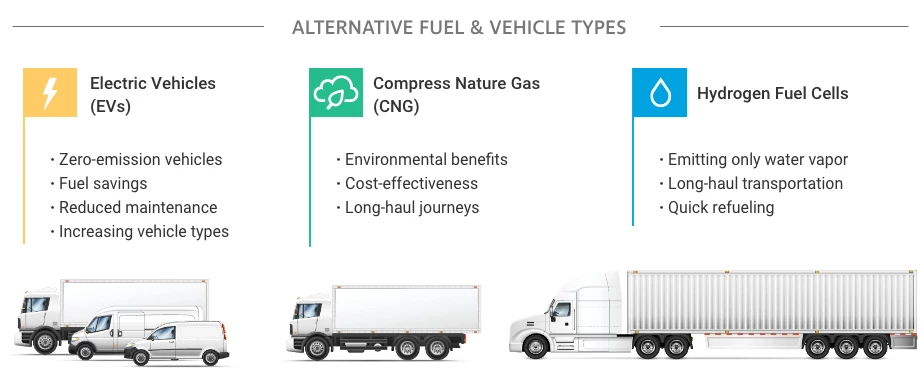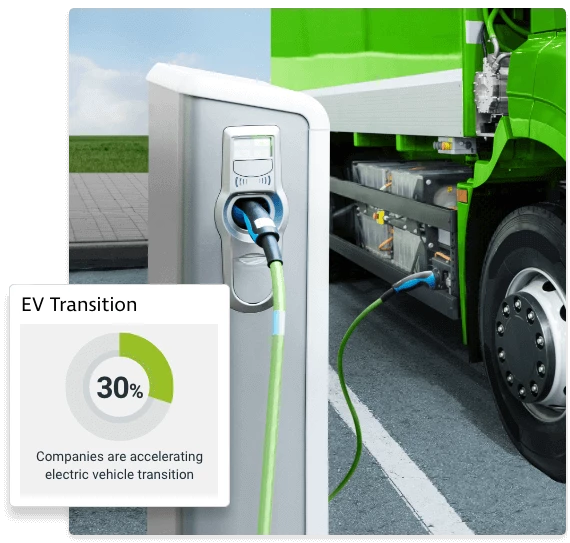Key Takeaways
As businesses globally aim for more sustainable operations, the transition towards alternative energy sources represents a seismic shift across all industries. The adoption of electric vehicles (EVs), compressed natural gas (CNG), and hydrogen fuel cell vehicles is gaining momentum, and each of these options offers its advantages, challenges, and ideal applications. Here’s what fleet operators need to know to prepare their fleets for the future.
Table of Contents
- Understanding the Shift to Alternative Energy
- Real-World Applications for Alternative Energy Vehicles
- Navigating the Transition
- How Technology is Helping Fleets Transition
- Accelerate Your Alternative Energy Transition
Understanding the Shift to Alternative Energy
Transitioning to alternative fuels is crucial for a more sustainable and environmentally friendly future. This shift requires a change in vehicle types and a shift in how fleets are managed and operated. Here are the primary alternative fuel options.
Electric Vehicles (EVs)
Electric vehicles are at the forefront of energy transformation. The vehicles use a large battery pack to store electrical energy that is used to power the vehicle's motor, and because they don’t produce tailpipe emissions they are classed as zero-emission vehicles. The growing variety and availability of electric commercial vehicles is making them a cornerstone of environmentally-friendly fleet strategies, but the high purchase cost, charging infrastructure concerns and shorter range are still prominent concerns.
When planning a transition to electric vehicles businesses should focus on the lifetime cost, where fuel savings, reduced maintenance and tax incentives offset the vehicle and infrastructure investment. They should also spend time assessing vehicle suitability, with range and public charging limitations, vehicles that have a return to base duty cycle and operate on shorter more predictable routes are often a good fit.
Compressed Natural Gas (CNG)
Compressed Natural Gas (CNG) operates by storing natural gas at high pressure, which is then used as fuel in specially designed vehicles. This alternative gains traction for its environmental benefits, emitting fewer pollutants than traditional diesel or gasoline options. Its viability for fleets stems from the cost-effectiveness and reduced carbon footprint it offers, making it particularly attractive for urban transport or long-haul journeys with substantial cargo. Despite these advantages, challenges include establishing a robust infrastructure for CNG refueling stations and addressing the initial investment in converting or purchasing CNG vehicles. Fleet operators must carefully weigh these considerations while evaluating the transition to CNG, ensuring a balanced approach that aligns with their sustainability goals and operational needs.
Hydrogen Fuel Cells
Hydrogen fuel cells are a promising facet of alternative fuel technology that operate by converting hydrogen gas into electricity through a chemical reaction with oxygen, emitting only water vapor as a byproduct. Their viability for heavy-duty and long-haul transportation lies in their ability to provide quick refueling and extended ranges, addressing critical limitations of battery electric vehicles. The potential game-changing impact on fleet management is underscored by the efficient utilization of space and weight in comparison to batteries. However, challenges such as the production and distribution of hydrogen, as well as the high initial costs of fuel cell vehicles, remain significant hurdles. Key considerations for widespread adoption involve advancing infrastructure, ensuring cost-effectiveness, and promoting global collaboration to enhance the overall sustainability of hydrogen fuel cell technology.

Real-World Applications for Alternative Energy Vehicles
Implementing alternative energy vehicles has already begun across various sectors, demonstrating their versatility and effectiveness in many scenarios. While these businesses may be ahead of the curve, rapidly advancing technologies are quickly making alternative energy vehicles an option across a wide range of industries.
Last Mile Delivery
Vehicles that are used for last mile delivery are often good candidates for electrification. These vehicles usually have shorter, return to base, duty cycles and operate in urban environments where the frequency of stops and availability of public charging overcomes the challenge of range anxiety.
Long-Haul Transport
CNG can be a good option for heavy trucks that travel long distances on known trucking routes. The predictability of the trips enables businesses to ensure that fueling stations are accessible, either on public sites or at owned facilities. In these situations, businesses can take advantage of the lower cost of fuel and reduce their impact on the environment.
Local Service
Similarly, to last mile delivery, local service vehicles are also good candidates for electrification. They usually operate in urban environments, have short duty cycles, return to base each day and carry lighter payloads, increasing the vehicles range.

Navigating the Transition
Transitioning to alternative energy vehicles is not without its challenges. However, the right approach can help businesses maintain a competitive advantage in the marketplace. Here are 5 key areas that fleet operators will need to consider when transitioning to alternative energy vehicles.
Vehicle Transition
The first challenge to overcome is selecting the right vehicles to transition. The key is to think about business continuity and ensuring that the transition is built around the way you work. This is where telematics data plays a critical role; knowing how each of your vehicles is used provides the insight to understand duty cycles, dwell times and trip locations, which will help you assess suitability to switch.
Developing Infrastructure
One of the significant hurdles in transitioning to alternative fuel vehicles is the development of the necessary charging or fueling infrastructure. Strategic planning is required to ensure vehicles can access charging stations or fueling points, minimizing downtime and maintaining operational efficiency.
Managing Infrastructure
In addition to developing an alternative energy infrastructure, considerations should be made on how this will be effectively managed, ensuring that you are optimizing how energy is acquired, stored and used.
Driver Training
Transitioning to alternative fuels often entails a learning curve for drivers. Effective training programs are essential to familiarize team members with the new technologies, focusing on maximizing vehicle performance and adhering to safety protocols.
Regulatory Compliance
Navigating the landscape of government regulations and incentives is another critical aspect of the transition to alternative energy vehicles. Staying ahead of regulatory requirements ensures compliance while bringing potential financial benefits through various government incentives.
Simplify Alternative Energy Transition
Reduce complicated processes with a simple and easy solution
Transitioning your fleet to alternative energy solutions can be complex but Teletrac Navman's platform helps make it simple. As you transition to a multi-energy fleet, get the data you need to actualize your decarbonization efforts and effectively plan your fleet transition so you meet your sustainability goals.
How Technology is Helping Fleets Transition
As more fleet operators are looking to accelerate their transition to alternative fuels, more and more technology is becoming available to support their transition and help with the management of a mixed energy fleet. Three of the key technologies are:
- Telematics Platforms. By providing insight into your fleet operation, telematics solutions enable you to take a data driven approach to your transition plans so you can be confident that your switch to alternative energy will have a positive impact on the environment, your team and business performance. With the right vehicle type segmentation and an understanding of the key data points to focus on fleet operators can build a data driven transition plan.
- Energy Management Software. These solutions bring together energy storage and management to help fleet operators mitigate the risks that could undermine the impact of their transition. With the capability to increase energy capacity, reduce high demand charges and optimize charging times, operators are provided with the insight to realize the benefit of their transition.
- Infrastructure Management Software. By providing visibility over an energy network, infrastructure management solutions allow operators to monitor and maintain equipment, ensuring it remains operational, while providing drivers a single point of control to manage charging or fueling.
Accelerate Your Energy Transition with Teletrac Navman
As the world gravitates towards more sustainable business practices, the transition to alternative energy is a business decision as much as an environmental statement. Teletrac Navman is uniquely positioned to support businesses with their energy transition, with access to the technology and know-how to help build effective transition plans, simplify mixed energy management and optimize energy consumption.
If you’re interested in speaking with our team about your energy transition contact our team for pricing information today.
Learn more Get Pricing
